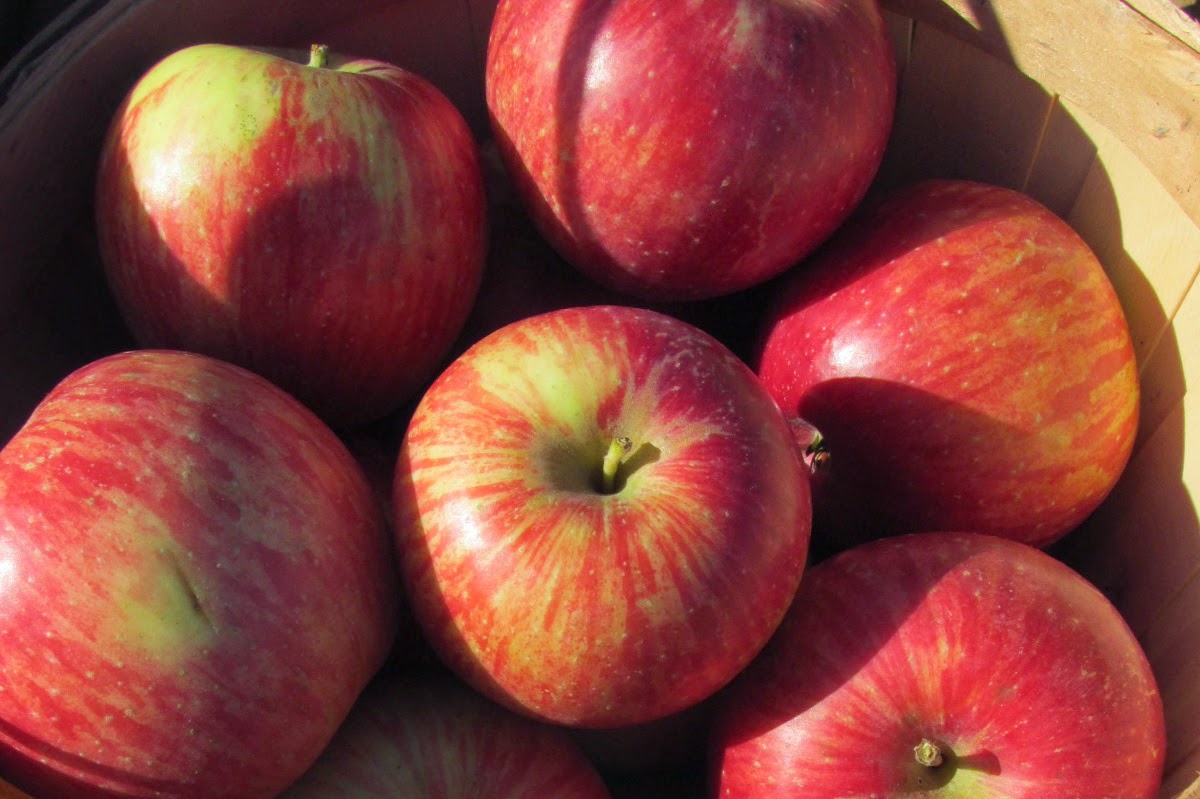Malus / Apple
malus / apple (fruiting)
With over 7,500 bred and registered cultivars worldwide and over 100 varieties grown commercially throughout the United States it's no wonder the fruit "rumored to keep the doctor away" is one of the most popular trees that we sell. While not every apple variety in existence will do well in our climate we carry several that have consistently done well in our region. Whether you're interested in fresh eating, baking, or just storing them for winter consumption, these fruit trees are sure to please.
Learn more about each of the varieties that we carry by reading further below.
dwarf:
Mature at about 8 - 10 ft. Dwarf trees have been grafted onto a root-stock to restrict their mature height and size.
semi-dwarf
Mature at about 12 - 15 ft. Semi-dwarf trees have also been grafted onto a root-stock to restrict their mature height and size. Some bred apple trees are naturally this size.
standard
Often mature at 18 ft or more. A fruit tree that is on it's own-root and has a mature size native to its own makeup.
haralson apple
Malus 'Haralson'
A hybrid cross ('Malinda' x 'Wealthy') from the University of MN, 1923. Named after Charles Haralson, superintendent of the University of MN Fruit Breeding Farm. A natural semi-dwarf tree that produces medium-sized red fruit. Hard, crisp and tart. Good dual purpose apple. One of the most popular apples in MN. Often bears fruit the first year. Prone to biennial bearing. Keeps well, will store until March. Fine hardy, winter variety.
Ripens: September - October
Recommended Pollinators:
Honeycrisp, McIntosh, Sweet Sixteen
Height: 8 - 12 ft
Spread: 6 - 10 ft
USDA Zone: 4 - 8
“it’s no wonder the fruit “rumored to keep the doctor away” is one of the most popular trees that we sell.”
hazen apple
Ripens: Late Late August - September
Recommended Pollinators: Haralson, Honeycrisp, Sweet Sixteen
Height: 10 - 15 ft
Spread: 10 - 12 ft
USDA Zone: 4 - 8
Malus 'Hazen'
A hybrid cross ('Duchess' x 'Starking Delicious') introduced by NDSU, 1980. Fruit is large and dark red. Flesh green-yellow, juicy. Flavor is sweet but mild, pleasant for eating, cooking, and as a dessert apple. An annual bearer. A natural semi-dwarf tree. Short storage life but a very hardy variety. Does very well without spraying.
The name "Hazen" was selected for this cultivar to commemorate two aspects of its origin. The town Hazen is near Mandan where the seedling originated. The late Dean Arlon G. Hazen who was Dean of the College of Agriculture and Director of the North Dakota Experiment Station while this cultivar was under test as a selection.
honeycrisp apple
Malus 'Honeycrisp'
A cross between ('Keepsake' x unnamed seedling) this University of MN, introduction in 1991 has quickly become our highest selling apple variety. An exciting apple that is exceptionally crisp and juicy. Flavor is sweet but well-balanced. Excellent storage life, up to 7 months. Has been rated equal to or higher in overall quality than 'Haralson', 'Honeygold' or 'Keepsake' in winter storage trials. Has become an outstanding commercial and home orchard variety because of its explosive crispness, flavor and storage life.
Ripens: Late September - October
Recommended Pollinators: Haralson, Hazen, Honeygold, Sweet Sixteen
Height: Depends upon Rootstock - Usually Semi-dwarf
Spread: Depends upon Rootstock - Usually Semi-dwarf
USDA Zone: 4 - 7
MCINTOSH
McIntosh Apple is not only a lovely tree, but provides delicious apples early in the season. One would look enticing anywhere in your landscape where you’re able to watch the daily developing of your bright red apple harvest. Its brilliant scarlet skin, thin and smooth to the touch, creates the perfect, crisp crunch when bitten into. The pink-streaked, white flesh is both juicy and tart, prized for a variety of culinary uses.
As the apples begin to develop, you’ll enjoy watching as your fruit transitions into red, decorative balls amid the vibrant green leaves. The McIntosh apple tree is a heavy producer of small to medium sized apples that ripen early,. In fact, your apples will be ready for harvest in mid-September and persist into early winter. The tree is cold hardy and partly self-fruitful.
McIntosh apple trees were discovered growing wild in Canada in 1976. It is the most popular cultivar in Eastern Canada and New England, and is sure to be one of your favorites as well.
Ripening: Late August - Mid September
Height: Naturally Semi-Dwarf 12 - 15 ft
Spread: Naturally Semi-Dwarf 8 - 12 ft
USDA Zone: 4 - 7
A semi-self fruitful apple.
state fair apple
Ripening: Mid September
Height: Depends on Rootstock - Generally Semi-dwarf (12 - 15 ft)
Spread: Depends on Rootstock - Generally Semi-dwarf (8 - 12 ft)
USDA Zone: 3 - 6
Malus 'State Fair'
Another hybrid cross ('Mantet' x 'Oriole') from the University of MN, 1978. This Medium-sized red striped fruit has good flavor and is sprightly tart and good for eating and baking. Good texture, semi-acid to sweet. All purpose apple. One of the better early apples for northern locations. Short storage life.
Recommended Pollinators:
Hazen Apple, Haralson Apple, McIntosh, Sweet Sixteen
sweet sixteen
Malus 'Sweet Sixteen'
Another hybrid ('MN447' x 'Northern Spy') from the University of MN, 1978. This apple has medium-sized red striped fruit with crisp, juicy texture. Excellent sweet, unusual flavor - like cherry candy. Outstanding dessert apple. Fire blight resistant. Can be slow to come into bearing. Good success in zone 3.
Recommended Pollinators:
Hazen Apple, Haralson Apple, Honeycrisp, McIntosh, Sweet Sixteen
Ripening: Mid September to October
Height: Depends on Rootstock - Generally Semi-dwarf (12 - 15 ft)
Spread: Depends on Rootstock - Generally Semi-dwarf (8 - 12 ft)
USDA Zone: 3 - 7
CARE: POSITIVES & DRAWBACKS
POSITIVES:
We are currently working to improve this portion of our site. Please check back later
DRAWBACKS:
We are currently working to improve this portion of our site. Please check back later.
PRUNING:
The optimal pruning time for Apple trees is late winter and early spring before leaves emerge.
For more on identifying old wood and new wood see our page on care of woody plants.













